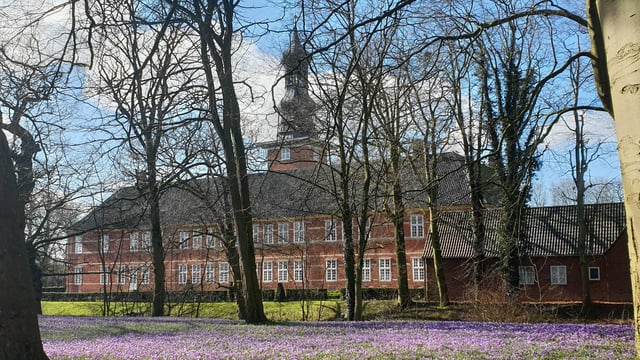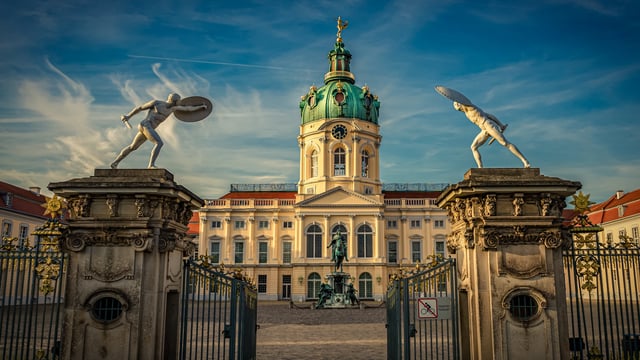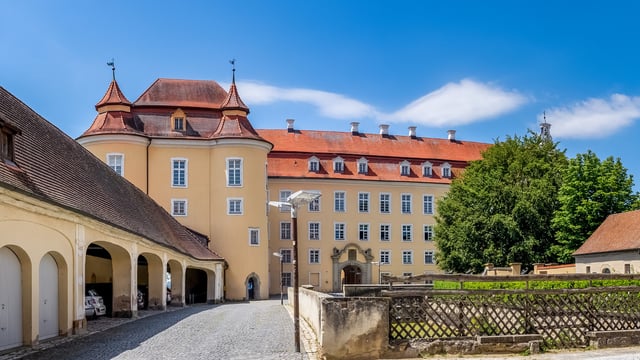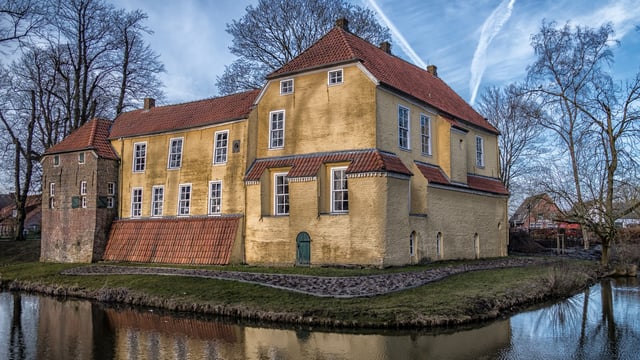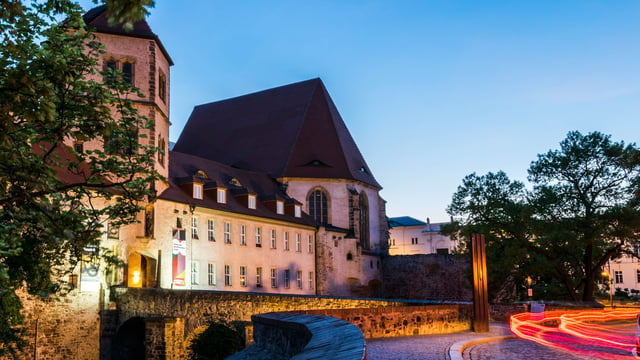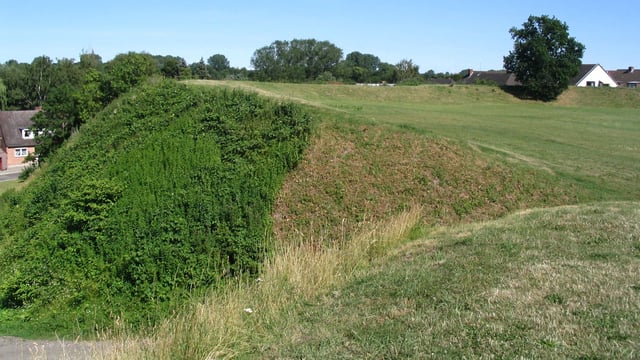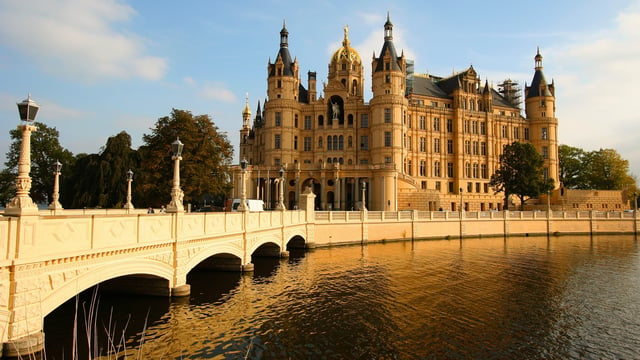Forts, Castles & Palaces in Germany
Albrechtsburg Castle, Meissen
Accepted by some as Germany’s oldest palace, this Gothic and Renaissance castle, and the site on which it was constructed overlooking the Elbe River, has had a long history. The first fortress was built in 929 for Henry 1, Duke of Saxony. And it was here in 1471 that brothers Ernest and Albrecht, both Dukes of Saxony, built their residential palace and administrative centre. Although they never used it as such. The Gothic masterpiece became a porcelain factory and in 1863 a museum. Innovative displays give insight into the castle’s complex history.

Anholt Moated Castle
The moated castle set within a Baroque English style park is one of the most beautiful castles of its kind in Münsterland. Although the earliest recorded mention dates back to the 12th century, it was around 1700 that the fortified castle was turned into a lavish stately residence for Prince Nikolaus of Salm-Salm. Today the castle houses a substantial art collection of some 700 masterpieces, including paintings by such artists as Rembrandt, Jan Brueghel the Elder and Holbein. Part of the castle is a four star hotel.

Brandenburg Castle
Known locally as ‘Burgruine Brandenburg’ are the remains of two castles, albeit built at different times in the mid 12th century. They each had their own towers, curtain walls with gates, and are located on a spur either side of a natural saddle. They do not feature in the history of the area, or Germany. Their greatest claim to fame is being called “Sleeping Beauty’s Castle” during the division of Germany as they lay in the restricted zone. Since Reunification they have been restored, and the residential tower of the Ostburg now houses a museum. The castle can be visited at anytime and makes for a great hike in the area, but the museum has set opening times.

Castle outside Husum
Construction on Schloss Vor Husum began in 1577 on the site of a Franciscan monastery. It was built for Adolf I, the first Duke of Schleswig-Holstein-Gottorf. At this time the castle was situated just beyond the town gate, hence its name. Just as this part of Schleswig-Holstein has changed hands between the Germans and the Danes, so too the castle has changed its role, from a ducal house to a royal residence for the Danish royal family. In May the park that surrounds the castle is a popular local attraction for the crocus blooms.

Charlottenburg Palace
With origins in the Baroque period and additions made until the 19th century, Schloss Charlottenburg is the largest palace in Berlin. This was the residence and ceremonial seat for Brandenburg electors, Prussian kings and German emperors. The palace was severely damaged in 1943, and it was feared that the ruins would have to be demolished. Rebuilding was completed in 1970 and soon after it was opened to the public and is now one of Berlin’s major attractions. The palace chapel and the bedchamber of Frederick I, faithful to the originals, are among the highlights of many visits.

Ellwangen Castle & Museum
From about 1460 CE the castle of Zllwangen served as the residence of the Prince-provosts. Although the castle was remodelled in a Baroque style around 1726, visitors to the castle can still see evidence of its earlier architectural grandeur. Today the castle is administrated by the State of Baden-Württemberg, and it hosts a museum with permanent exhibitions that comprise spectacular objects from over 1,200 years of the building’s history and influence in the region.

Hanstein Castle, Bornhagen
Considered one of the most beautiful ruined castles in central Germany, Hanstein Castle certainly makes for a picturesque silhouette among timber-framed buildings. First mention of the castle dates to 1070, noting its destruction. Given its strategic value, the castle was rebuilt and damaged several times in its history. As it was close to the border between East and West Germany, the CDR took control of the ruins and the towers used as a border watch tower. No visitors were allowed until after Reunification. A popular medieval festival takes place at the castle every year on the first weekend of August.

Hohenzollern Castle
On the edge of the Swabian Alps atop Mount Hohenzollern, Hohenzollern Castle has breathtaking views. The current castle, built in Gothic revival style between 1846 and 1867, is the third castle to have been built here. Since the 11th century this has been the ancestral home of the House of Hohernzollern, specifically the Swabian branch of the family. Besides being able to tour historic rooms, a number of artefacts from the Prussian royal family are on display, including the Crown of Wilhelm II.

Kronprinzenpalais
Built in 1663, but remodelled and renovated many times since, the Crown Prince’s Palace has been home to many members of the Prussian Royal family. The last Emperor of Germany, Wilhelm II, was born here on 27 January 1859. After the dissolution of the German monarchy, in 1919 the palace became part of the National Gallery, where it showcased Modern Art until ordered to be “cleansed” of it by Hitler. The palace was heavily destroyed during the Allied bombing of Berlin, but again restored. On 31 August 1990 the palace hosted the signing of the German Unification Agreement.

Manningaburg
In the centre of the East Frisian town of Pewsum is a small moated castle, the origins of which date back to 1458. Once the seat of the Manninga family, in 1565 the castle was sold to Count Edzard II, an East Frisian Lord. The castle was substantially rebuilt, but the ravages of time and repair costs took their toll. Today only the first floor of the castle remains with a small courtyard, a wide moat and the gatehouse. The castle houses a museum inside to the East Frisian lord and the history of the castle.

Moritzburg Castle, Halle
Built in the final decades of the 15th century for Archbishop Ernest of Saxony, Moritzburg Castle is one of the finest examples of a residential late medieval fortress. By the beginning of the 16th century under Cardinal Albert of Brandenburg it was a magnificently furnished archbishop’s residence. An almost regular quadrangle, it was surrounded by a swampy moat. The castle suffered considerable damage during the 30 Year’s War. The castle lay in ruin until 1900 when renovations commenced and it became the venue for the art museum of the state Saxony-Anhalt.

New Palace
Built between 1763 and 1769 Neue Palace was Frederick the Great’s last palace in Sanssouci Park. It was also the official residence of the last German Emperor, William II. Before Kaiser William the palace was not a royal residence, rather it was built, at the end of the 7 Year’s War, to host state events and accommodate official guests. The magnificence of this large palace was intended to convey Prussia’s power, wealth and victory after the war. The palace has over 200 rooms, some of which have recently been restored and can be visited today. Highlights include the Grotto Hall, the Marble Hall and the Concert Hall.

Nuremberg Imperial Castle
The castle in Nuremberg comprises a series of fortified buildings and a city wall. Together they are one of the most formidable medieval fortresses in Europe. Earliest mention of the castle dates back to the mid 11th century. The castle was one of the Imperial residences of German kings as Holy Roman Emperors, as they moved about their realm. And it was here that they held their Court assemblies and Imperial diets. During WWII the castle suffered considerable damage, taking 30 years to fully restore. Exhibitions in the castle, designed to appeal to all ages, outline the historical context of the fortress, as well as the role of Nuremberg in the Holy Roman Empire.

Old Castle, Stuttgart
At the heart of the old city, still commanding an imposing sight, is the Altes Schloss. Originally built for the Duke of Swabia in the mid 10th century, in the 13th century it became the residence of the House of Württemberg. The moated stronghold, walls of which can still be seen in the basement, became a luxury Renaissance castle. With the building of the New Palace in the mid 18th century, the castle was then all but an outbuilding. Today the castle is home to the State Museum of Württemberg, one of the finest history museums in Germany.

Oldenburg Slavic Burg
In the middle of the town of Oldenburg in Holstein stands a typical Slavic burg – fort or castle. The first phase of this structure was built towards the end of the 7th century AD, making this the oldest Slavic castle in Germany. And one of the most important archaeological sites in Schleswig-Holstein. Even in the 11th century it was known as the ‘old castle’, hence the origins of the name of the town. Excavations in the 1970s and the 1980s revealed the site was a princely court in the 9th and 10th centuries, with an episcopal church and pagan sanctuary.

Orangery Palace
Inspired by Villa Medici in Rome and the Uffizi in Florence, the Orangery Palace is the last and largest of the royal places in Sanssouci Park. The style of the palace is a clear reflection of King Frederick William’s IV love of Italy and Italian architecture. Constructed between 1851 and 1864, the two wings of the palace are still used to overwinter plants susceptible to the harsh winters. The central section, known as the Raphael Hall, houses 19th century reproductions of the Renaissance painter Raphael, made by Prussian artists. The palace had both servant’s quarters and guest apartments; the latter of which were lavishly decorated.

Sanssouci Palace
Sanssouci Palace was Frederick the Great’s favourite place to retreat to, particularly in summer. It was his wish to be buried here. A wish that was finally granted in 1991 when he was reburied on the highest terrace of the vineyard in front of the Rococo style palace. Constructed between, 1745 and 1747 based on the ideas and sketches of Fredericks, today the elegance and grandeur of the interior is achieved with the use of original furnishings. Sanssouci, French for without worry, is the most famous of all the Hohenzollern palaces in Potsdam.

Schloss Boitzenburg
This late 19th century neo-Renaissance castle has had a chequered past. Today it is a children’s and youth hotel, but before this it was a convalescent home for the National People’s Army of former East Germany. For much of its history the castle was the ancestral seat of the von Arnim family, who were responsible for the building we see today. Earliest mention of a castle on this site dates to 1276. But the land and the castle has changed hands many times, with successive owners building a new castle.

Schwerin Castle
Set on a small island in Lake Schwerin, Schwerin residential palace is one of the most important examples of Romantic architecture in Germany. The spectacular neoclassical castle was built in the mid 19th century on the foundations of Slavic fortress dating back to the 10th century, and later buildings from the 16th and 17th century. This was the residence for the Dukes of Mecklenburg, and the beautifully restored stately rooms (including the sumptuous Throne Room) are open to the public. Today Schloss Schwerin houses a museum as well as the State Parliament of Mecklenburg-Vorpommern.

Spandau Citadel
Considered one of the finest and best preserved Renaissance fortresses in Europe, what we see today was built during 1560 and 1594 for the Brandenburg Elector Joachim II to protect the city of Berlin Cölln. The pre-existing 12 century castle was no longer deemed fit for purpose. The Julius Tower is the oldest standing secular building in Berlin. During the Nazi era a chemical weapons laboratory was housed here. Since the end of the War it has been used solely for civilian and cultural activities. It houses a number of museums and galleries, including a local history museum and an exhibition of monuments from 1849 to 1986 that have been removed from public view. Guided tours show the dramatic history of the Citadel.

Wilhelmshöhe Palace
The 18th century Neoclassical palace was built for Landgrave Wilhelm IX of Hesse. It replaced an earlier 17th century, which itself replaced an earlier castle that had been fashioned out of a 12th century monastery. Today the palace houses an Old Masters Gallery, a collection of Egyptian, Greek and Roman antiquities, and a collection of over 60,000 prints and drawings. The palace is part of the Bergpark Wilhelmshöhe UNESCO World Heritage site.

Zabeltitz Baroque Palace
In 1728 extensive remodelling of an earlier residential castle was carried out for the Imperial Count of Wackerbarth by a well-known builder Johann Christoph Knöffel. Prior to the castle, a medieval moated fort stood here, having been built to protect a salt road. Today the palace is also known for its French inspired Baroque garden, one of the most important historic parks in Saxony. A permanent exhibition inside the palace gives visitors the history of the palace and gardens.







